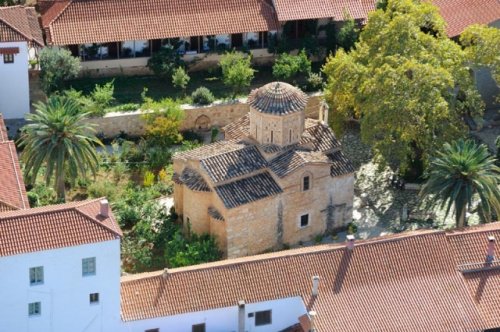Monastery of Loukou
Monastery of the Transfiguration of Christ
At a beautiful location with a panoramic view, scattered with antiquities, at the plain of Thirea, at a small distance from Astros, is the Monastery of the Transfiguration of Christ, which is called Monastery of Loukou.
There are a lot of views regarding its name, with most prevalent one the one relating with the Latin word lucus, which means idyllic location, sacred grove.
It is built at the location of ancient Eva, at the ruins of the temple of Polemokrates, which during the Early Christian period has been converted into a church, while next to the monastery there is the mansion of the sophist Herodes Atticus, in the 2nd century AD.
The present day catholicon of the monastery, it is later than the Early Christian basilica. It was built in the 12th century, as it is indicated by an engraving of 1117, but also by its masonry. The monastery was a stauropegic one, that is it was directly under the authority of the Ecumenical Patriarchate, according to a sigil by the Patriarch Dionysius II, in the middle of the 16th century.
During the period of Venice Occupation and until 1715 it fell into the hands of Roman Catholic Cistercian monks. During the Turkish Occupation, due to its prosperity, it played an important role, supporting the school of the area and the liberating struggle. In 1826, under the threat of the troops of Ibrahim, it was abandoned and was torches by the Turks. Miraculously the catholicon survived and the monastery operated again approximately ten years later. Since 1946 it has been a women’s monastery.
The monastery complex depicts the whole history of the area, since in its precinct there are scattered architectural members, while many are walled-in in the more recent buildings. At the centre of the area is the catholicon, a cross-in-square church with a dome supported in four columns.
Externally it has a rich ceramic decoration and Roman sculptures incorporated in its masonry, while marble sculptures decorate the floor. Internally the church is richly decorated with excellent wall paintings. The wall paintings date from 1649 and they are the work of a unknown painter.
The wooden-carved screen and the despotic icons, such as the miraculous icon of the Transfiguration date from the middle of the 17th century. Around the catholicon there are two-storied buildings, cells, chapels and the post Byzantine tower, one of the four that were initially here.
The monastery’s library is exceptional, and they keep 300 volumes of manuscripts, patriarch sigils, codices, and many relics. The monastery celebrates on the 6th of August.
Northern Kynouria is one of the best-preserved treasures of the Peloponnese
Northern Kynouria is one of the best-preserved treasures of the Peloponnese. Hidden amidst mountains and the Argolic Gulf, this region combines stunning natural beauty with its rich culture and history.
7 destinations that are worth visiting when you find yourself in Astros Kynourias
Accommodation in Arcadia

If you're seeking that magical sense of escape and the breath of fresh air and the touch of authentic Greek nature then staying in Arcadia is your gateway to an experience that words can hardly capture.
From its picturesque mountain villages to the lush slopes of Mount Mainalo and the hidden valleys with their flowing streams, every corner of Arcadia invites you to live slower, deeper, and more genuinely, all while enjoying excellent accommodation options.
Whether you choose to stay near Dimitsana, Stemnitsa, or Karytaina, or prefer more secluded spots like Lagkadia or Vytina, accommodation in Arcadia is more than just a practical matter, it’s part of the experience. Stone mansions, traditional guesthouses, and warm, welcoming lodgings create a setting that honors the region’s architecture and history.
Discover Arcadia
.jpg)
7 days in Arcadia, Up the Arcadian Mountain, An… island in the embrace of Arcadia How is beauty spelled in the Tsakonian language? Where Arcadia reaches the sea

Monasteries





